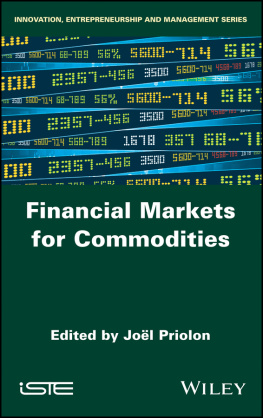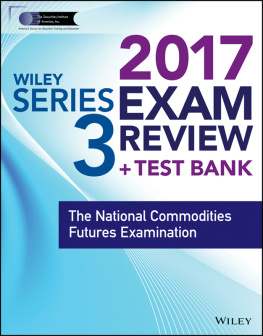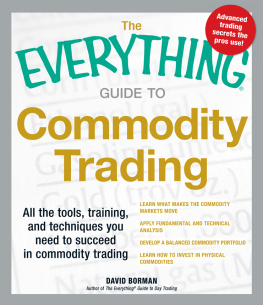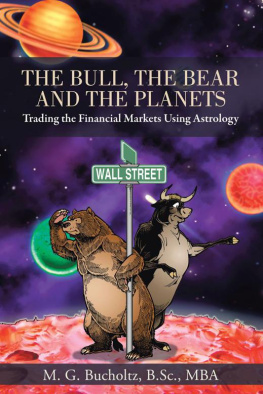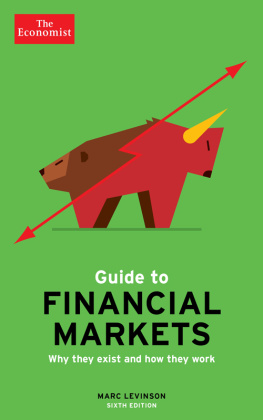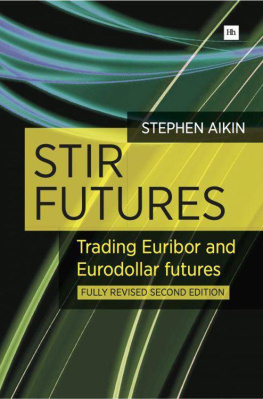
Series Editors
Jack Legrand and Gilles Trystram
Financial Markets for Commodities
Edited by
Jol Priolon

First published 2019 in Great Britain and the United States by ISTE Ltd and John Wiley & Sons, Inc.
Apart from any fair dealing for the purposes of research or private study, or criticism or review, as permitted under the Copyright, Designs and Patents Act 1988, this publication may only be reproduced, stored or transmitted, in any form or by any means, with the prior permission in writing of the publishers, or in the case of reprographic reproduction in accordance with the terms and licenses issued by the CLA. Enquiries concerning reproduction outside these terms should be sent to the publishers at the undermentioned address:
ISTE Ltd
27-37 St Georges Road
London SW19 4EU
UK
www.iste.co.uk
John Wiley & Sons, Inc.
111 River Street
Hoboken, NJ 07030
USA
www.wiley.com
ISTE Ltd 2019
The rights of Jol Priolon to be identified as the author of this work have been asserted by him in accordance with the Copyright, Designs and Patents Act 1988.
Library of Congress Control Number: 2018959050
British Library Cataloguing-in-Publication Data
A CIP record for this book is available from the British Library
ISBN 978-1-78630-362-2
Preface
This book was born out of two sets of courses that we were lucky to be able to conduct for quite a long time for very enthusiastic students. The first set of courses were meant for and are still intended for engineering students, most of whom do not work in the field of commodities but who still wish to understand the fundamental principles underlying the working of these markets. The second set of courses is meant for students of economics and engineering students who are specializing further, following their initial training, with a masters in economics of the environment, energy and transport.
The book that has resulted from these two sets of courses is, in fact, a summary that has been hugely augmented by the additional course material that we gradually developed. It consists of a very descriptive set of materials that aim to present the basic mechanisms of the financial commodity markets: forward markets, call options and swaps markets. These fundamental mechanisms are not very difficult to understand, however they still require a certain amount of effort in order for the reader to become familiar with them. Although we resort to a few simplifications, we present all the elements that are essential for a rigorous comprehension of the subject; in this sense, the book presents no impasse, and thus, the reader who has assimilated all the information we present can understand how the financial commodity markets function.
This book is also, partly, a work on economic theory. Our aim was to show how economists use conceptual frameworks that they find familiar to represent and analyze these markets. On first reading, a reader who is unfamiliar with the theory may find it a little difficult to understand the analytical scope of these conceptual approaches. We are, nonetheless, convinced that the analytical frameworks used by economists are essential for shedding light on the subject. Similarly, some developments in financial mathematics are also presented as certain aspects of the functioning of the financial markets cannot be approached with any rigor without using the mathematical instruments on which they were founded, both theoretically and empirically.
We have chosen to give as simple an explanation of the subject as possible, but have also retained all that is essential to an authentic comprehension of the financial commodity markets. Consequently, certain passages in this book may at first seem difficult, but these few arduous explanations are not gratuitously inserted for denseness. They represent certain inevitable examples. If the reader who takes up this book feels the need for specific motivation, it would be good to remind them that essentially knowledge of the financial commodity markets in fact represents an advanced step toward a comprehension of all financial markets.
Jol PRIOLON
October 2018
Introduction
Physical commodity markets are markets where products that have material reality are bought, sold and delivered. Financial commodity markets are markets where financial contracts are negotiated. The value of these contracts is derived from the value of the commodities. Prices form on each market; the central objective of this book is to describe and analyze the dynamics of physical prices and financial prices, with the trickiest point being understanding the joint dynamics of these two groups of prices.
Commodities agricultural, sources of energy or minerals are mainly used in the initial phases of a production cycle. For example, corn serves as fodder for animals but is also used to produce fuel; oil makes it possible to provide fuel and other by-products in chemistry; and iron is a basic product in the steel industry. The concept of what a commodity is can vary from one activity to another. To take just one example: corn is undoubtedly considered as a commodity. However, for certain industries, the commodity is the starch which makes up about of 7273% of corn. It appears difficult in practice, and quite futile, to try and define commodities based exclusively on their physical characteristics. And thus, we offer the following definition: [] in practice, the first form through which the product obtained from a natural resource can travel through the next phase of its transformation is called a commodity [GIR 15]. Commodity trading is a highly technical activity, reserved either for specialized companies or for specialized departments of more general organizations. This trading is highly globalized and there is fierce competition through prices.
In this book, we will study those commodities where at least a part of the trading is via organized financial markets. As a result, we will exclude certain commodities for which there exists no financial market. For example, to the best of our knowledge, there is no market where forward contracts or call options are traded around cement. Another example: in France, there is no futures market for potatoes, which poses some problems for actors in this sector. It is not possible to draw up a list not even an approximate list of the commodities for which there is no financial market; it is, however, important to note that the absence of a financial market is not necessarily definitive as all that is required for a market to be created eventually is for a sufficient number of actors to express an interest in developing this market. If we go back to the origins of the financial markets for agricultural commodities the mid-19th Century in the American Northwest it can be seen that it was because traders, farmers and industrials simultaneously took an interest in this that the Chicago Board of Trade was established [MOR 79]. On the contrary, certain markets that performed well for a time disappeared when there was no longer a sufficient number of participants to keep it alive. The world of financial markets evolves constantly: certain contracts appear, and others disappear. All of the markets that endure do, however, have one point in common: they interest a diverse and sufficiently large group of operators for contracts to be negotiated using these markets as the intermediary.
continues in the same manner, but reviews more recent texts. Given the proliferation of literature, we have chosen texts that offer diverse perspectives on questions of regulations. At the end of this technical, often arduous study, we offer a lengthy conclusion with an overview of some of the questions that arise for the regulators. We have also tried to offer our answers to these questions.
Next page
